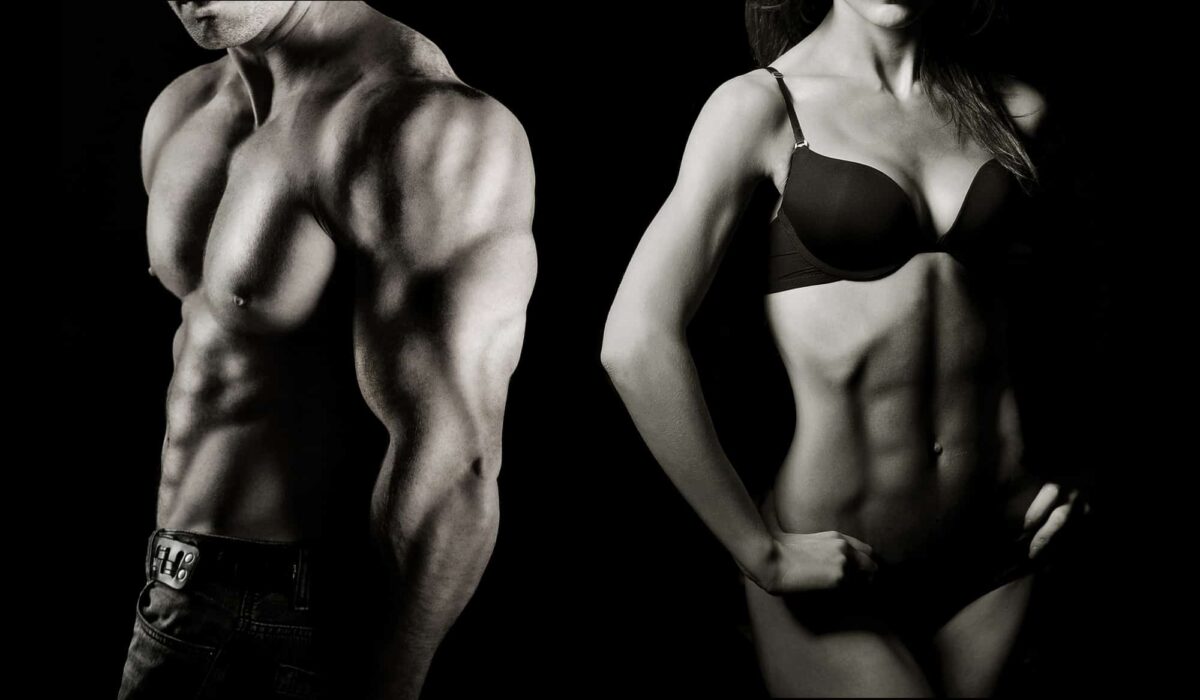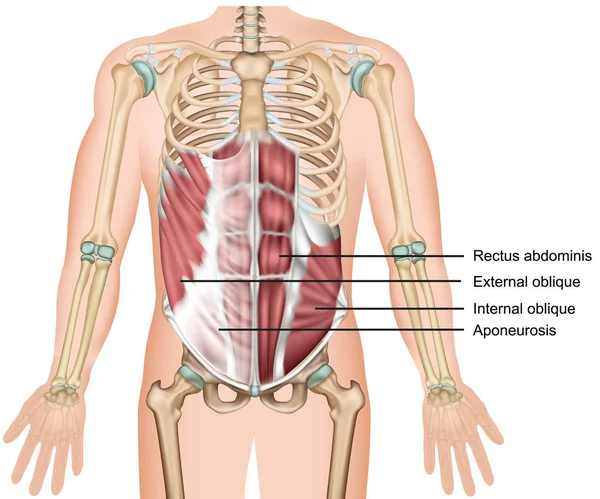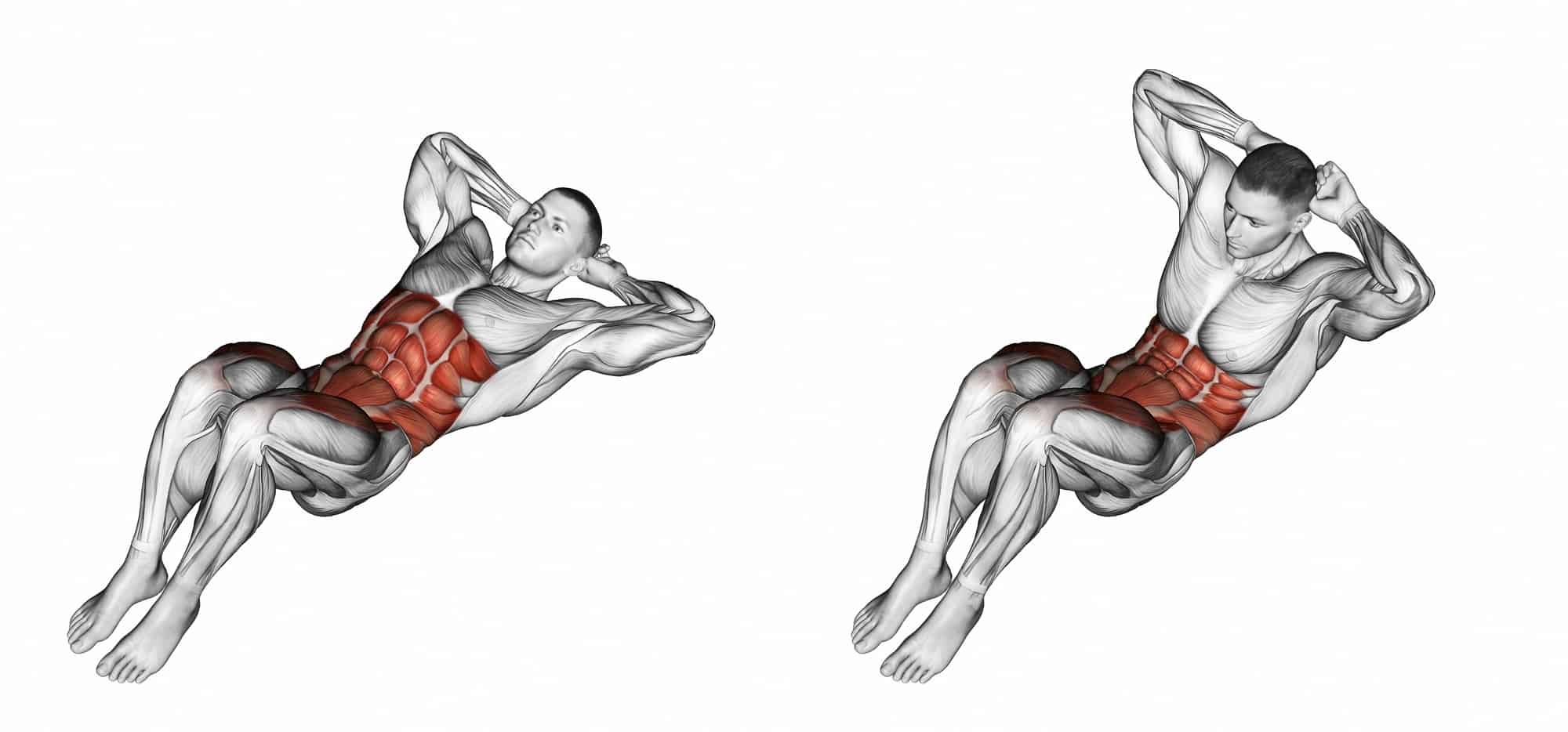Upper Abs Exercises? Do they exist, and how effective are they? That is the question that a few beginners wonder. They simply see the catchy clickbait titles and believe them. As you browse social media, you regularly see such promising videos worth an instant click. And influencers don’t want to dive deeper into whether you can actually train upper and lower abs separately or not. Today, I’d like to discuss with you such a touchy topic and find out once and for all – are the best exercises for upper abs a fact or a myth.
According to the anatomy books, the muscle responsible for a six-pack, as we call it, is not that complex – it’s not divided into several muscle groups that can benefit from isolation movements. So, unfortunately, the magical promises to improve only one part is far from true. The verdict? Myth! More on how these muscles work and how to train them properly later in the article!
Now that we know that many influencers lie to us, it’s research time! We’ll see how to create that six-pack based on science and facts!
Can You Train Upper Abs Separately?

It seems that abdominal muscles are the subject of the biggest misconceptions in the modern fitness community. As you browse social media, you regularly see such titles as
10 Best Exercises for Upper Abs
Show Off Your Lower Abs in Just 10 Days
Do you see the issue with these titles? I certainly do! Having spent more than a fair share of my previous years following professional coaches and physiotherapists, I’ve learned quite a lot about how you can’t really train either lower or upper abs. This is an issue that has been quite vocal in the community recently. Nevertheless, you can still see such titles everywhere. And it’s great if an influencer tells you the truth in the introductory part, but that’s rarely the case.
What Is Alexis Ren Ab Workout Routine?
You see, there are several parts of abs; in particular – four muscle layers:
- external oblique
- internal oblique
- transverse abdominis
- rectus abdominis
The detailed illustration:

As you can see in the picture, there are no lower and upper abs in the typical understanding. The frontal muscle, rectus abdominis, is a whole long muscle – the one that you usually call “the six-pack.” Know that this pack is a package deal; it’s trained as a whole.
Its primary function is to move your body between the ribcage and pelvis. Thus, it’s always trained when you either reduce the distance or increase it.
Abs Versus Hip Flexors
Often, when you search abs exercises, social media offers sets that are only half as useful for rectus abdominis. In fact, many exercises that people have come to believe are useful for abs engage hip flexors instead. Here are a couple of examples that, I’m sure, you’ll recognize:
- seated/lying leg raises
- mountain climbers
- dead bug
All these exercises do for rectus abdominis is strain it in static to hold your body. How to differentiate what exercises target abs instead of hip flexors? Remember that you are looking for exercises where your ribcage moves closer and farther from the hips. This is the golden rule.
Unfortunately, in our rush to build strong abs, we may be bringing more harm to our body by over-loading our hip flexors. According to corrective exercise professionals, tight/overactive hip flexors lead to movement impairment.

How to Train Abs Effectively?
Up to this point, we’ve determined that you can’t really train upper and lower abs separately. Though specific exercises are “felt” more in the upper abdominal region than lower, this is one big muscle compartment that trains simultaneously.
With that clear, we’ll have to discuss the most effective ways to build abs. You still want those rock-hard muscles, right? Both upper and lower.
Quick 5-Minute Ab Workout At Home
First, there are the general recommendations for regular fitness activities. Without sport, we’ll stay Jell-O and weak. But you need a strong and resilient body, right? Core and abs are in the core of a powerful body (pun intended.)
Here are five main rules meant to help you build nice strong abs and power up your core.
Add Resistance
When developing any other kind of muscles in our bodies, we march to the weights stand immediately. Additionally, we use training machines for resistance. But why do so many people neglect strength training when it comes to building abs? You see people crunching relentlessly. That alone won’t give you the desired result results. It’s like focusing on squats for building glutes. Come on, bring more diversity, add weights. This will be the fastest way to bring definition to those muscles, provided that your diet is healthy, of course. But more on that later!
With abs, you’d want a bit of hypertrophy to bulk up those squares. Of course, strength is required, but I’d like to discuss visual definition as it interests people the most.
Hypertrophy is achieved by a moderate number of reps paired with progressive overload.
A 2019 research proposes three-six sets of six to twelve reps.
If you are interested, I encourage you to check the offered tables compiled during the research showing the beneficial results of the approach.
Abs Are Made in the Kitchen

As believe you’ve heard this saying repeatedly already. This website is among those instances as well. Personally, I’m a big fan of the phrase “abs are made in the kitchen.” Well, that’s because it’s true. No matter how much you try to define your abdomen by training, you only get a bigger stomach. As you’ve noticed, your abs may be growing, but they do it from within. So, you can easily have a magic set of a six-pack, but it’ll be hidden under inches or centimeters of fat. And it’d be very fat to reduce your fat percentage without a healthy diet.
If you seek pointers on switching to a healthy diet, you can check advice from my colleague Ana – a certified nutritionist. She has a comprehensive list of topics about diet, nutrition, and everything related.
Put Emphasis on Flexing and Extending
As I’ve said in the abdominal anatomy section, the primary function of the abs part that most of us want to train is moving the body between the ribcage and pelvis. Thus, your training should be mostly focused on moving in this plane.
Unfortunately, the beloved (hated) planks are mostly good for core durability but not muscle definition.
Training obliques requires flexing to the sides and rotational movements. Unfortunately, there is a poor variety of proper abs exercises compared with other muscle groups like legs or glutes. But I’ll list some of the most effective of them below.
Keep Your Back on the Floor
During abs/core exercises, it’s of utmost importance to keep your lower back plastered on the floor. Naturally, when we have weak core muscles, the standard response is arching our back. Do not do that! This way, you’ll shift the focus from your abs to other muscle groups at the least. At the max, you risk injuring your back!
Allow Regular Rest

Abs and core are crucial to our body’s proper functioning. They are engaged in the most compound and all full-body exercises. It means that your regular training still engages core muscles when you train. Thus, adding separate abs-dedicated workouts to your regime should be done with care. As they are so often engaged, you can start training them separately about once a week for a “defined” result.
There is no need to train abs as often as you would with other muscle groups. They receive enough hard work as it is. And proper rest is something that all of us need at this age more than ever. Considering that most of us like to push our bodies to the max, we often forget about the importance of proper rest. At the same, you can clearly see how celebrities value it when training with professional coaches. Proper rest is something that all coaches preach to the trainees.
How to Tone Your Stomach: 6 Best Exercises
If you still have doubts about its importance, you can check this research published in 2012 about Overtraining and recovery.
6 Best Abs Exercises
Here is a list of five basic yet effective exercises for your abdominal muscles. All of them engage your abs in dynamic movements and build a nice six-pack. Provided that your fat percentage is low enough for them to show.
Dumbbell Side Bend
This exercise focus mainly on the obliques. Choose the comfortable weight for the dumbbell not to strain muscles so much, especially if you don’t train obliques specifically.
How to do:
- Stand with your feet shoulder-width apart.
- Take a dumbbell in on hand.
- Bend in your waste to one side and then to the other. Keep your hips and spine straight.
- Make 10-12 reps on one side and switch the dumbbell to the other hand.
Crunches

Yes, you should not limit yourself to crunches alone, but the exercise is still effective in combination with others. It targets the frontal ab muscle – rectus abdominis and can strengthen it.
In case you don’t how to do crunches (also check the illustration):
- Lie down on your back. slightly bend your knees, keep feet shoulder-width part.
- Put hands across your chest.
- Lift your upper body closer to the knees. Make sure your shoulders lift up a bit, not all the way up. Keep your neck relaxed.
- Stay crunched for about half a second and lay back down.
High Cable Crunch

To my mind, this is the most underestimated abs exercise of all! It is super effective in engaging your rectus abdominis with added weight!
Unfortunately, you’ll need a cable machine for this one; so, doing it at home will be hard. But can try to fix something up.
- Lower to your knee in front of the cable machine. Stay strong and firmly connected to the ground with your shins.
- Hold the cable by your head.
- Flex abs and crunch/lower towards the floor. Hands should be fixed in one position by the head.
- Pause at the bottom for half a second and rise up.
Toe Touches

This is one of the regular exercises done by Cristiano Ronaldo! Have you seen his abs? That’s your prove in the effectiveness of toe touches!
- Lie flat on your back.
- Raise your leg high to form a 90-degree angle. Stabilize! Keep your knees slightly bend not to overstretch hamstrings.
- Raise your arms up reaching for the toes.
- Flex your abs and lift shoulder blades off the floor.
- Try to reach your toes with your finger. Pause when up. Remember to keep your neck relaxed.
- Lower your shoulder blades and repeat as needed.
Russian Twist
Russian Twist is the most effective exercise for strengthening your obliques. Beginners are recommended to start with bodyweight, keeping legs slightly on the ground. Advanced athletes do this exercise with added weights plus with feet off the ground.
Simple beginner version:
- Sit on the floor. Back straight, knees bent. Keep your feet/toes touching the ground.
- Angle your straight back slightly backward to create a 45-degree angle.
- Raise your hands forward in front of your torso and clasp them.
- Twist sideways to the left with your abdominals and, then, to the right.
- This is one repetition. Continue as needed.
Alternate Heel Touches

This exercise can become a beginner alternative to Russian Twist if you are new to working out! It’s way easier to do, but also engages obliques.
How to do:
- Lie on your back in the position similar to crunches. Feet a bit wider than shoulder-width. Keep hands stretched along your body.
- Crunch your torso forward and to one side. Try to reach your heel with fingertips.
- Return to the starting position and crush to the other side.
5 Simple Boat Pose Variations for Perfect Abs
In Conclusion
I’m glad that we’ve finally busted the myth about all those upper/lower ab exercises. Modern fitness influencers use the stereotype in abundance to attract a wide audience and clickbait their videos. If you like the offered exercise, you can still follow the routine as it’ll strengthen your core, abs, and hip flexors as a package deal.
To boost your results in building a six-pack, I strongly advise you to follow all four tips I’ve mentioned above – they were chosen by the recommendations of several physiotherapy and coaching professionals.
 Fact checked by
Fact checked by